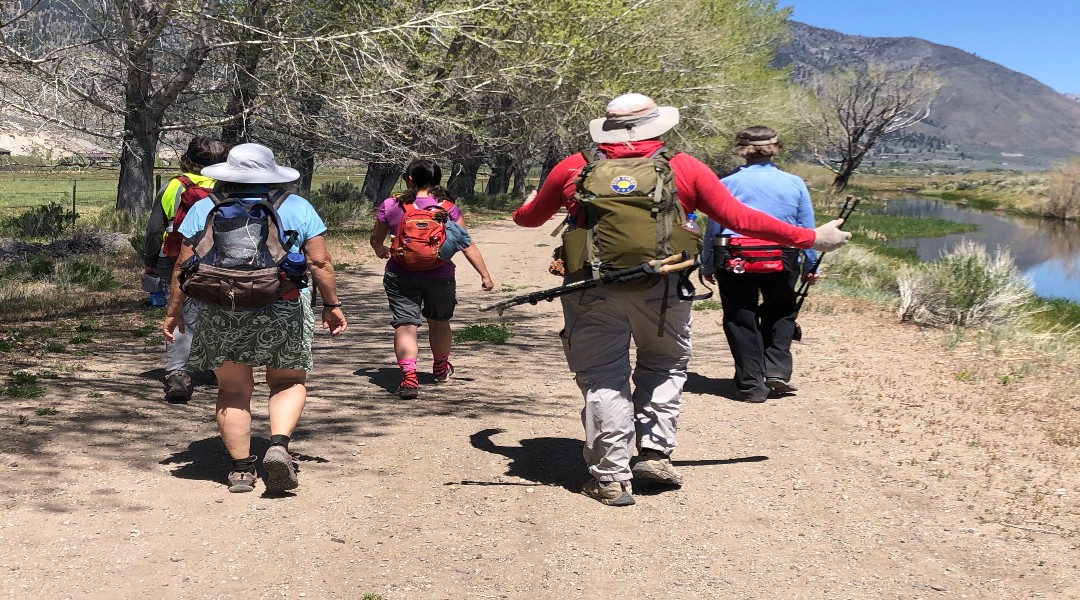How to Prevent Hiking Injuries of the Feet and Ankles
If you love exploring the outdoors, you can’t do much better than living right here in northern Nevada and the Carson Valley! The Carson Valley Trails Association has helped create and actively maintains more than 50 miles of public trails throughout six systems, serving an estimated 87,000 hikers annually.
Although if you really want to enjoy the great views—particularly on the more difficult trails—you want to be sure your feet are protected and up to the task. Nothing spoils a pristine hike like a foot or ankle injury, particularly if you still have a 6-mile walk to get back to your car.
The following are a few simple tips to help reduce your risk of hiking-related injuries:
9 Tips to Protect Your Feet on Your Hike
Choose a good pair of hiking shoes/boots. Choose a hiking shoe that matches your intended activity level. If you are only planning to walk for a few hours on flat and smooth terrain, you might prefer a lower-cut hiking shoe. But if you plan on carrying more gear or embarking on more challenging and difficult trails, a high-cut hiking boot will provide better ankle support and a stiffer midsole may be more appropriate. Be aware of the outsole of your footwear. Depending on the material and geometry, the outsole acts as a defensive layer from the small rocks and debris on the trail. Outsoles are designed for traction and cushioning. The harder rubbers used for most hiking boot outsoles are obviously more durable and will grip better on wet and muddy terrain. Additionally, full-grain leather uppers or Gore-Tex are an added benefit for foot protection, durability, and weather resistance.
Make sure your boots fit! Try before you buy! Nothing feels worse after a few hours than an ill-fitting hiking boot. Your shoes/boots should not feel tight, but offer good wiggle room for the toes. Because feet tend to swell up after you’ve been hiking for a while, we suggest shopping for footwear later in the day or after exercising. It is recommended to add ½ size to accommodate your feet swelling. It’s better to be ½ size too big than too small. We also suggest trying on your shoes/boots while wearing the same type of socks you’ll be hiking in.
Don’t forget about socks! Breathable, moisture-wicking hiking socks are designed to provide additional cushion to the front and the heel of the foot, they’ll help keep you cool and minimize the risk of blisters. This extra cushion also has a happy side-effect too, – it makes the socks more durable. Every bit of cushion helps prevent the foot from “throbbing” towards the end of a long hike. Some hikers prefer to wear two pairs of socks — a breathable trail sock on the inside, and heavier wool sock on the outside to absorb moisture and keep it away from the feet.
Hiking Compression Socks. Hiking compression socks can help keep you going longer – and to be less tired when you get there. They’re particularly good for trekkers with varicose veins or other circulation issues. Wearing compression socks while you’re hiking will help increase circulation in the legs, which boosts oxygen and recovery time for muscles and tissue. However, incorrect use of compression socks can injure your skin and create unwanted conditions. If you’re unsure about using hiking compression socks, talk to your primary care provider or your local podiatrist. If you have serious concerns about the blood flow in your legs, Sierra Foot & Ankle does offer services and treatment for neuropathy, a loss of feeling in the feet and legs.
Pre-tape. If you know you have a few “hot spots” where you tend to get blisters, using medical tape on those spots before you begin to hike. This will often help stop them from occurring in the first place.
Powder in your shoes/boots! Foot powders typically have talc and a good amount of Salicylic Acid to absorb moisture, odor, and help with redness, swelling, and prevents irritations. A sprinkle of medicated foot powder in your shoes helps keep them dry and inhibits fungal growth.
Trekking poles. The use of trekking poles can be especially beneficial to keeping your balance and reducing wear and tear on your feet and knees. The first time I used trekking poles was on an excursion to summit Mt. Whitney and I’ve been using them ever since.
Check the forecast. Don’t get caught out on the trail when severe weather or temperatures drop suddenly. Conditions can get dangerous in a hurry.
Carry emergency gear. The amount you need to carry will vary based on how long you plan to hike. Some essentials to consider include:
- First aid supplies (bandages, blister pads, splints, etc.)
- Food and water
- Extra pairs of socks
- Pocket knife & Duct tape
- Sun protection (sunscreen, sunglasses, wide-brimmed hat)
- Rain poncho
- Fully charged cell phone with spare battery/power bank
Tell someone your plans. Be sure someone not on the hiking trip knows where you’re going and when you plan to be back, especially if you plan on exploring less-traveled trails.
Listen to your body. While it’s normal to feel a little worn out after a day on the trail, pain and exhaustion are signs that something is wrong. Know your limits, take breaks when you need them, and if you’re in pain, get back to the car and, if necessary, seek further care.
Foot and Ankle Care for Hikers
As a hiker and backpacker myself, I am passionate about helping outdoor enthusiasts protect their feet and recover quickly and completely from any injuries that keep them from doing what they love.
If you’re currently dealing with a hiking-related injury, or are having problems with foot and ankle pain, then we’re here for you! Sierra Foot & Ankle specializes in many advanced, non-surgical treatments that can help hikers and trekkers of all kinds shorten their recovery time and get back on the trail sooner, including:
- MLS laser therapy
- Shockwave therapy
- Lightweight, 3D-printed custom orthotics
Don’t let painful feet stand in the way of fully enjoying all the gorgeous hikes and trails that the Carson Valley has to offer! Follow the tips above, and please give us a call if you need help. Now go out and enjoy your hike!
Get In Touch
Address
2350 South Carson St
Suite 3
Carson City, NV 89701
Contact
Call: (775) 783-8037
Fax: (775) 782-3787
OPT-IN To Text:
By texting our office at
(775) 783-8037 from your mobile phone, you are consenting to receive SMS text messages from our staff. Reply STOP to unsubscribe.
*Read our Privacy Policy & Terms and Conditions.
Social




© Sierra Foot & Ankle. All Rights Reserved. Privacy Policy.
Web Design by CP Solutions. Marketed by VMD Services.

